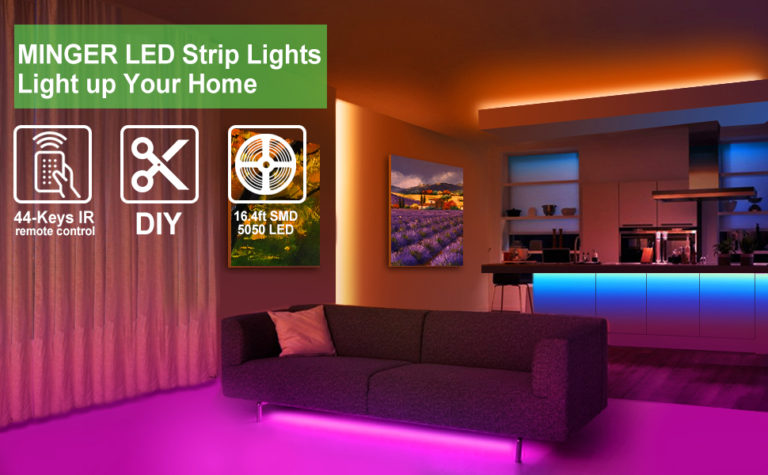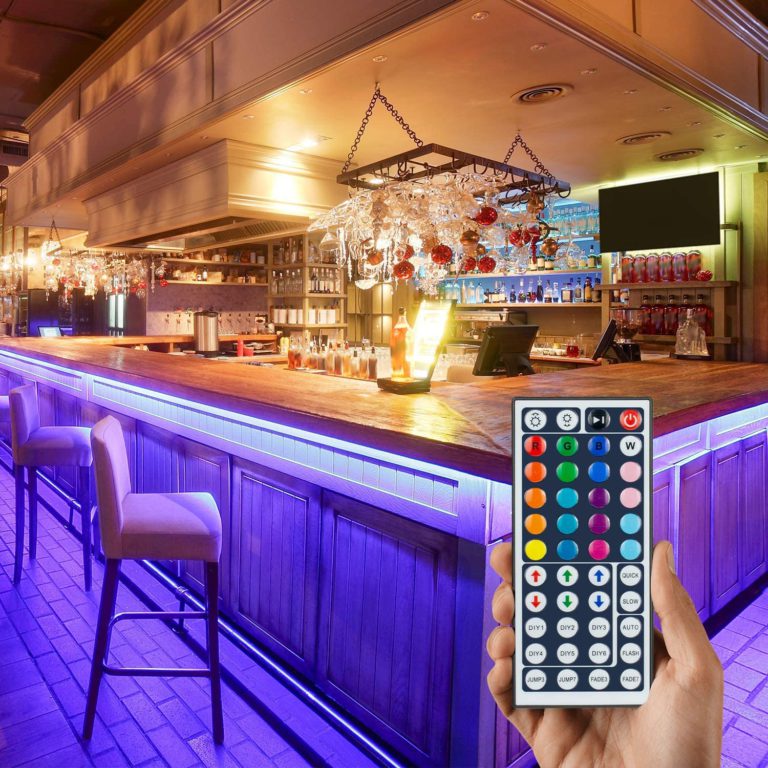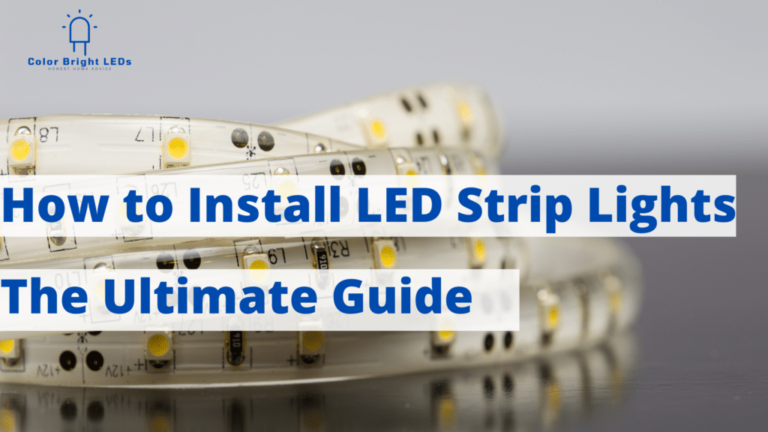Best Color LED Light Strips People also ask
LED light strips are a very popular and creative way to experiment in lighting design. They are used in indirect lighting applications to help enhance your decorative effect while providing additional lighting where needed.
Considering their attractiveness, LED strip lights have become very versatile and it is not surprising that they can meet the needs of many consumers. Some light strips are flexible, while others are rigid light strips.

Which LED strip light color is best for the eyes?
When exposed to high-intensity light, the eyes will be affected. If the light emits high flux, please keep a certain distance to reduce the impact on the eyes. The white light we see in the LED is the general blue in the spectrum with a wavelength of 450 nm.
The eyes are less sensitive to blue, so they put more pressure when seeing light, and the green on the other side is very sensitive. The two factors considered when choosing the color of LED light strips are color temperature and color rendering index.
The brightness is high, which is stressful for the eyes, while the warm white LED is good and good for the eyes. The 4500k temperature range of the LED, the natural light range is good for the eyes. It shows the clarity of the object under the light. A good LED light strip has a high CRI, which can show the state of the object under natural light.
Warm white LEDs have a CRI of over 90 and cool white LEDs over 62. This is better for your living room or living room. Cool white LEDs are most suitable for kitchens and dining areas.
How to Choose the Best LED Strip Lights
Of course, light will affect people’s moods. LED lights strip can highlight different colors and adjust people’s moods. On the one hand, different colors have different promotion effects on people’s emotions.
The same color will give people different feelings at different brightness levels. Before purchasing an LED light strip, please consider these factors to ensure that your choice meets or exceeds your expectations for the intended application.
Location of Use
Before deciding which product to use, it is important to determine where the LED light strip will be installed. Some are designed for specific purposes, such as step lighting or TV backlighting.
This specialization distinguishes them from ordinary LED light strips. For example, a product designed for TV backlighting might come with four pre-cuts and TV-specific timing options that change colors to mimic the colors on the screen.
Other location considerations include water resistance for terrace use, dimmer compatibility in bedrooms, LED light strips or motion-sensing LED light strips in corridors, bathrooms, or stairs.
Even a more general installation location, such as a wall or ceiling, is worth considering before buying, lest you end up with a special product that is not designed for the location you want to place.
Length
Lamps come in a variety of lengths, ranging from 1 foot to 32 feet on average, depending on their brightness and purpose. LED strips designed specifically for TV backlighting or use on stairs are often shorter to facilitate installation.
The low-brightness LED light strip can be up to 32 feet long and can install 300 LED lights strip. High-brightness LED light strips will have the same number of LED modules but can be up to 16 feet long.
However, if necessary, most flexible light strips can be cut with scissors to shorten them. Or, if you need a longer LED tape, you can connect the parts to customize the required length.
Flexibility
Most light strips have a flexible circuit board that is used to bend at corners or run on curved surfaces. Some LED light strips are very flexible, you can bend them 90 degrees without damaging the circuit board. However, as the power of the LED light strips increases, the flexibility will decrease, and some strips are completely rigid in design.
These inflexible products are often much shorter, sometimes only a foot long, and are much brighter than ordinary light strips. They can also be combined with motion detection technology, making them ideal for lighting stairs.
Brightness
The brightness of the LED light strip is measured in lumens per meter or LM and is determined by the density of the LED lights strip within one meter. The brightness may be difficult to determine by yourself, and some manufacturers do not include this information. By paying attention to the density of the LEDs, you can find the average brightness of the light strip.
The average lamp comes with two densities: standard density (SD) of 30 LEDs per meter (9.1 LEDs/ft) or high density (HD) of 60 LEDs per meter (18.3 LEDs/ft).
- Twelve standard density (SD) strips produce an average of 540 LM and require 27 watts of power. They are 32.8 feet long.
- Thirteen high-density (HD) strips provide an average of 1080 LM and require 40 watts of power, with a maximum length of 16.4 feet.
Color and color temperature The color of the light strip is very important and needs to be kept in mind. Some light strips have only one color, while other light strips may have millions of colors to choose from.
The color option you choose depends entirely on your personal preferences. Color temperature is measured in degrees Kelvin (K) and describes how warm or cold the color of light appears.
The soft glow of ordinary incandescent bulbs has cold light at 2700K, while natural light is much warmer, with an average of 6500K. However, this is only a factor of the transparent light bar, you can choose a single color.
Our Top Recommendation
No matter which type of LED light strip you buy, you want it to be a high-quality product. These LED light strips are some of the best based on past purchase factors, prices, effects, and reputation.
Generic LED Strip Lights Smart Color Changing Rope Lights
Features:
Application control and microphone mode:
control the LED light strip bar through the application, remote control, and controller. The Led light strip has an intelligent music mode and a built-in microphone with adjustable sensitivity to create a romantic, relaxing, and musical party atmosphere. The color of the light will change with the rhythm of the music or the microphone.
Dimmable LED light strip:
This RGB LED strip The Light Kit has 300 high-quality 5050 LEDs with brightness and dimming controls. You can choose dynamic modes, such as blinking, breathing, strobe, gradual change, cool, etc.
User-friendly:
The music sync LED light strip has a memory function. When the strips are reused, they will remember the last mode setting without repeating the setting. Environmental protection, saving money, no radiation. It can be cut between every 3 beads, so you can adjust them to the correct length.
Multiple scenarios are available:
This is not only suitable for indoor use, but also outdoor use. It can be used to decorate your dining room, bedroom, upstairs, kitchen, porch, computer desk, Christmas tree, bar, and living room, especially suitable for Christmas, Halloween, parties, and other holidays and activities. It is an ideal gift for family and friends.
Easy installation:
complete accessories, equipped with LED light bar, AC power adapter, 44-key infrared remote control, and instruction manual.
How to Install LED Strip Lights?
Step 1. Dry and clean the surface
Before attaching any light strips, clean the surface of the area where the light will be placed. This is essential to maintain the installation for a long time. It is recommended to stick the light bar on a smooth and stable surface.

It should not be placed on rough or textured surfaces or surfaces that can be bent or moved.
Step 2. Unroll the light strip, stick to the surface
The LED light strip is rolled on a reel. Simply unfold the length of the light you will use, remove the adhesive and stick it on the desired surface. Press down on each part of the strip so that it adheres firmly to the surface and is free of air bubbles.

You can use fixing clips to strengthen the installation of the light bars and ensure that they are fixed in place. Remove the masking tape and stick it on the surface of the non-sticky area on the light bar. If necessary, you can further secure the clip by screwing it to the surface.

Step 3. Connect LED light strip and turn on the light

After fixing the light strips, you can connect them to the controller and power adapter, and then plug them into the power socket. To use the remote control, first, remove the insulating sheet and press any color on the remote control to change the light color.





